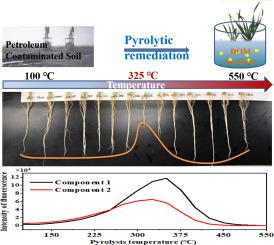Science of the Total Environment ( IF 9.8 ) Pub Date : 2021-02-19 , DOI: 10.1016/j.scitotenv.2021.145921 Xun-Fang Xi , Wei-Fei Hu , De-Chang Li , Shun-Feng Jiang , Hong Jiang

|
Pyrolysis, as a convenient and fast technology, has been proved to be promising in the remediation of oil-contaminated soil. However, little is known about the dissolved organic matter (DOM) associated with pyrolyzed oil-contaminated soil and its environmental impact. Herein, optical spectroscopic techniques (i.e., absorbance and fluorescence) were adopted to reveal the relationship between the pyrolysis temperature and the characteristics of the DOM and the associated phytotoxicity. Results show that one of the main factors determining the properties and phytotoxicity of DOM leached from the pyrolyzed soil is the critical temperature (approximately 325 °C) during pyrolysis. When the temperature was lower than 325 °C, more types and quantities of DOM, mainly fulvic acid-like substances, were desorbed from the soil with the temperature, which have little effect on wheat growth. However, when the temperature was in the range of 325–550 °C, the type and quantity of DOM increased first and then decreased as the temperature increased, during which the organic matter in the soil decomposed. The wheat growth was first inhibited and then promoted. Finally, the correlation between the spectral indices of DOM with the phytotoxicity suggested that fluorescent components identified by parallel factor analysis were positively correlated with phytotoxicity. This study indicates the pyrolytic remediation of oil-contaminated soil should avoid some critical temperature ranges.
中文翻译:

热解修复法研究油污染土壤中溶出的有机质
热解作为一种方便快捷的技术,已被证明在修复受油污染的土壤方面很有前途。然而,对于与热解油污染土壤相关的溶解有机物(DOM)及其对环境的影响知之甚少。在本文中,采用光谱技术(即吸光度和荧光)揭示了热解温度与DOM特性和相关的植物毒性之间的关系。结果表明,决定从热解土壤中浸出的DOM的特性和植物毒性的主要因素之一是热解过程中的临界温度(大约325°C)。当温度低于325°C时,随着温度的升高,更多的DOM类型和数量从土壤中解吸出来,主要是黄腐酸样物质。对小麦的生长影响很小。但是,当温度在325–550°C范围内时,DOM的类型和数量先增加,然后随着温度的升高而降低,在此期间,土壤中的有机物分解。小麦生长首先受到抑制,然后得到促进。最后,DOM光谱指数与植物毒性之间的相关性表明,通过平行因子分析确定的荧光成分与植物毒性呈正相关。这项研究表明,油污土壤的热解处理应避免在某些临界温度范围内进行。在此期间,土壤中的有机物分解。小麦生长首先受到抑制,然后得到促进。最后,DOM光谱指数与植物毒性之间的相关性表明,通过平行因子分析确定的荧光成分与植物毒性呈正相关。这项研究表明,油污土壤的热解处理应避免在某些临界温度范围内进行。在此期间,土壤中的有机物分解。小麦生长首先受到抑制,然后得到促进。最后,DOM光谱指数与植物毒性之间的相关性表明,通过平行因子分析确定的荧光成分与植物毒性呈正相关。这项研究表明,油污土壤的热解处理应避免在某些临界温度范围内进行。



























 京公网安备 11010802027423号
京公网安备 11010802027423号